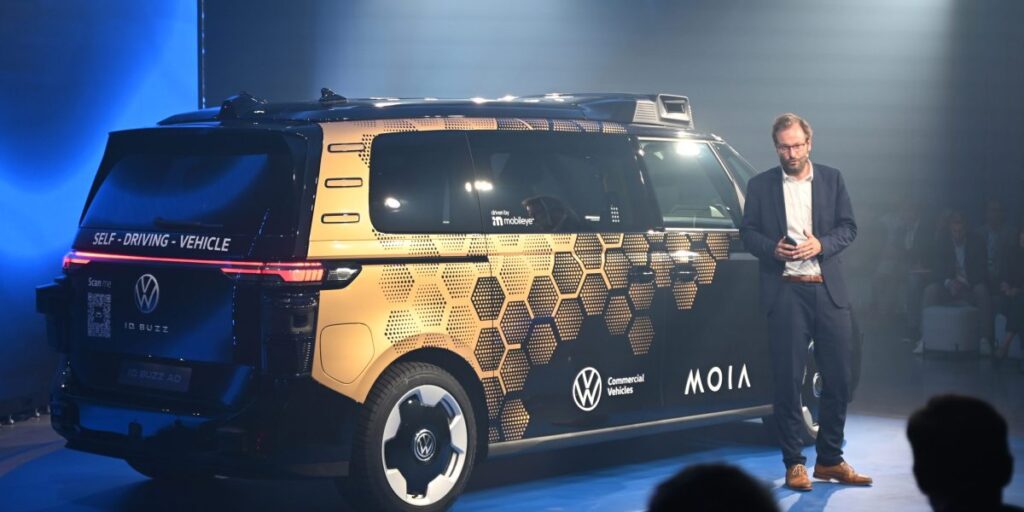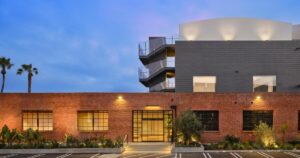
LOS ANGELES – Volkswagen Group has announced a major leap into the autonomous vehicle market with the unveiling of its robotaxi, poised to join Uber’s fleet in Los Angeles next year. This strategic move highlights Volkswagen’s ambition to compete in a market projected to grow by half a trillion dollars over the next decade.
Breaking: Volkswagen’s Strategic Entry into Autonomous Ride Hailing
Volkswagen Group is determined to carve out a significant presence in the burgeoning autonomous ride-hailing sector. The company revealed its white-label robotaxi, which Los Angeles residents will soon be able to hail through the Uber app. Unlike its tech-focused competitors, Volkswagen plans to focus on being a supplier, allowing companies like Uber to manage the fleets.
“Profit margin expectations in the mobility sector tend to be in the low single digits, in automotive they’re ideally in the high single digits. But in AI, they begin in the double digits. That’s the big opportunity for Volkswagen in the future,” said Christian Senger, VW Group executive leading the initiative.
Immediate Impact: A New Player in the Autonomous Market
The announcement comes as other automakers like General Motors and Ford have exited the autonomous ride-hailing race, leaving a gap for Volkswagen to fill. With plans to deliver an initial batch of 480 robotaxis to Uber next year, Volkswagen aims to capitalize on a market that is finally moving towards reality.
Key Details Emerge: Volkswagen’s ID. Buzz AD
Volkswagen’s ID. Buzz AD, a production-ready version of its iconic microbus, is tailored for the autonomous market. Designed to comfortably transport a family of four with luggage, it features a powered sliding door for easy access and a spacious interior.
“This should be able to transport a family of four complete with luggage to the airport,” explained Senger, CEO of Volkswagen Autonomous Mobility.
High-Tech Sensor Suite
The ID. Buzz AD is equipped with a sophisticated sensor suite, including eight LiDAR devices, 13 cameras, and five radar sensors, allowing it to detect objects up to 300 meters away. This technology is seamlessly integrated into the vehicle’s design, enhancing both functionality and aesthetics.
Industry Response: A Competitive Landscape
Meanwhile, industry experts warn that the competition is heating up. Waymo is expanding into New York City, Zoox has opened a manufacturing plant, and Tesla is testing vehicles in Austin. Volkswagen’s entry into this competitive landscape is a bold move.
By the Numbers: Volkswagen’s Ambitious Plans
- Initial delivery of 480 robotaxis to Uber in 2024
- Potential orders for up to 10,000 vehicles
- Vehicles capable of speeds up to 75 miles per hour
What Comes Next: Future Implications
The timing is particularly significant as regulatory barriers and market infancy present challenges. However, Volkswagen’s strategy to offer a white-label package with backend software and a digital booking platform could position it as a leader in the field.
Expert Analysis: Strategic Partnerships
Volkswagen has partnered with Intel’s Mobileye for its autonomous driving systems. This collaboration allows Volkswagen to leverage Mobileye’s extensive experience and technology, providing a competitive edge in the market.
Background Context: A Decade in the Making
This development builds on years of investment in autonomous technology. Despite setbacks faced by other automakers, Volkswagen’s commitment to innovation and strategic partnerships underscores its long-term vision.
Regional Implications: Los Angeles as a Testbed
Los Angeles, known for its traffic and innovation-friendly environment, serves as an ideal testbed for Volkswagen’s robotaxi. The city’s adoption of autonomous vehicles could pave the way for broader acceptance and integration across the United States.
As Volkswagen prepares for its robotaxi debut, the automotive industry watches closely. This move represents a significant shift from traditional car manufacturing to a future where autonomous vehicles play a central role in urban mobility.






